Applications in the Cloud: Best Practices for Delivery, Security and Visibility

In environments that span from on-premises to public cloud, private cloud and hybrid clouds, application delivery, security and visibility can become complex and inefficient.
With 84 percent of enterprises now using a multi-cloud strategy, according to the RightScale 2019 State of the Cloud Report from Flexera, this issue is more pressing than ever before.
Ahead, we’ll talk about the challenges of delivering applications across multiple environments while maintaining security and visibility. Then, we’ll explain what companies can do to overcome those challenges.
Read to learn about:
- Growing industry trends and challenges
- Microservice architecture challenges
- Visibility, analytics and insights
- What you can do today
Best Practices for Application Delivery, Security and Visibility in the Cloud
Organizations expect to achieve agility, better ease of use, rapid deployment, elastic scaling, automation, and increased operational efficiency. But how can you ensure that your applications are secure and that you have visibility regardless of where your apps reside?
Growing Industry Trends
Today, all companies are undergoing digital transformation in some form. Regardless of industry and focus, technology is now at the center of how enterprises are run. Here are some of the trends that have risen to prominence as a result.
Applications Are Changing
Widespread use of mobile devices has put applications at our fingertips. Apps are an integral part of every company and they are expected to be updated, delivered and deployed as quickly as possible.
This shift can be observed in the microservices movement. As monolithic architectures have been replaced with microservices architectures, applications are no longer delivered as a single, self-contained program.
Instead, applications are now divided into smaller components that must be delivered in concert. Oftentimes, those components are managed through container platforms like Docker and Kubernetes, as illustrated below:
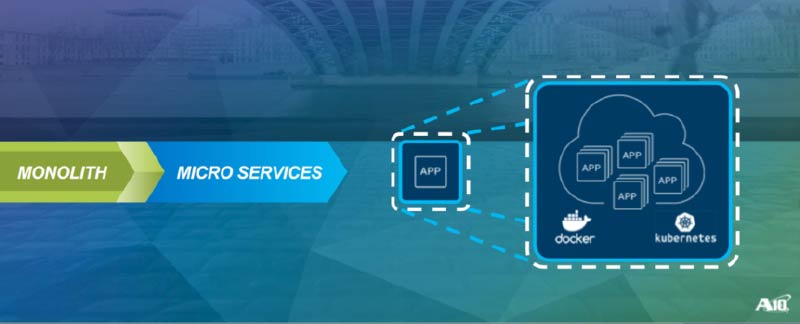
Deployment Models Are Changing
Applications aren’t all that’s changing: deployment models have also undergone a dramatic transformation.
Thanks to global demand for application availability and agility, apps are no longer bound to the data center. Rather, applications are deployed across multiple data centers and in a multi-cloud environments.
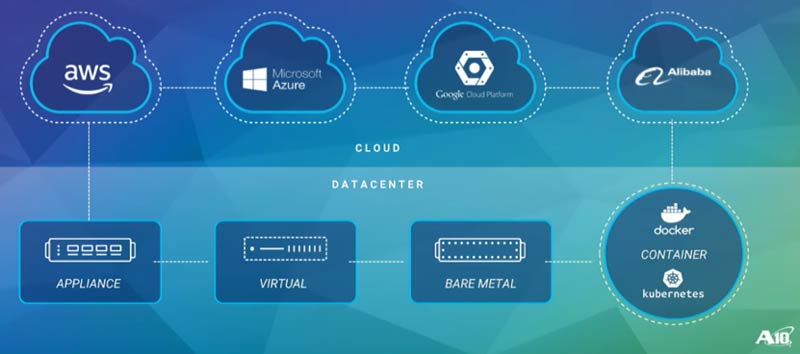
Today, we see not only the traditional application delivery services but cloud-native application delivery, which provides conventional load balancing but is designed to meet the agility and flexibility requirements of multi-cloud and hybrid-cloud environments.
That being said, current infrastructures aren’t disappearing. Rather, companies must find a way to make their existing data centers work in tandem with microservices and cloud-based infrastructures.
This creates a degree of complexity that can present significant obstacles to companies of all kinds.
Key Challenges We’re Facing
As these trends converge, businesses are up against a specific set of challenges. Here are the four primary challenges we see and their technology-driven solutions:
- Driving agility: To meet more aggressive time to market (TTM) deadlines, companies need agility. That means automation and self-service wherever possible.
- Supporting multiple environments: From traditional data centers to public clouds and private clouds, enterprises must figure out how to support a variety of applications across multiple environments. This demands streamlined management solutions that are quick, easy to use and able to efficiently migrate applications from one environment to another.
- Increasing efficiency: Managing applications and providing consistent security requires complete visibility and operational intelligence. Detailed analytics can do this and are vital to quick troubleshooting. And as environments continue to diversify, this is becoming more essential.
- Security: In the past, enterprises only had to worry about securing east-west traffic, or traffic that occurs within the data center. Now, they also need to secure north-south traffic, or traffic that moves in and out of the data center. This includes traffic flowing to and from the cloud, as well as traffic flowing between microservices.
And now you have challenges specific to microservices architecture.
Since 90 percent of enterprises are using or planning to use microservices, as detailed in LightStep’s 2018 Global Microservices Trend Report, the vast majority of companies must now consider:
- Micro-segmentation with auto encryption: Enterprises must ensure that when traffic flows between micro-segments, it’s automatically encrypted for security purposes.
- Auto service discovery: The reason microservices work is that when one microservice instance goes down, the orchestration system will create a new one. So, companies need to map that process and efficiently direct traffic to the new instance.
- Complete visibility: Companies need to see what’s going on between the microservices as well as within the applications themselves.
How to Resolve Those Challenges
Ultimately, the objective is to deliver a consistent, user-friendly experience when deploying applications.
The truth is, users don’t care about where your applications reside or what kind of architecture you use. They only care about their experience, and to make that experience great, enterprises need to resolve the challenges discussed earlier.
But how? Through automation, management, and visibility and control.
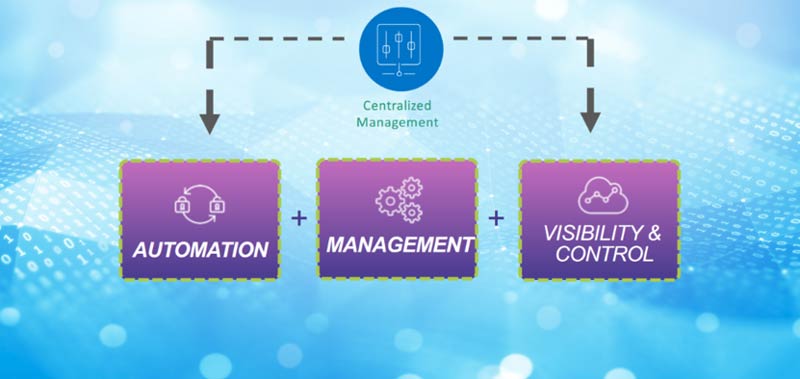
Automation
Businesses require faster and more frequent application delivery. This means that infrastructure and IT teams need to be able to deliver agility to support those demands. Businesses need intelligent automation that is API-driven so that businesses can become more efficient.
Management
Automation on its own isn’t enough. Companies also need a centralized management solution that increases operational efficiency and agility by enabling the IT teams and application teams to work together to centrally configure and manage all applications and policies across any environment.
Keep in mind that only a dedicated central management solution will be able to deliver those results across multiple environments. Unless all of a company’s applications are located in a single cloud, built-in cloud management solutions will be inadequate.
Visibility and Control
Visibility is now more crucial than ever before. That’s because it’s not only about dashboards that allow companies to simply monitor and watch. It’s about per-application visibility, which makes efficient troubleshooting possible.
Essentially, enterprises need to take a proactive approach to application management, and that can only be accomplished with complete visibility. Also keep in mind that the load balancer is the best place to examine traffic and gather information.
But, the thousands of lines of log messages produced by load balancers are impractical for analysis and troubleshooting. So, enterprises need a central system that can analyze those logs and generate big-picture insights based on both cloud and on-premises traffic.
The ideal solution will offer four tiers of visibility, analytics and insights:
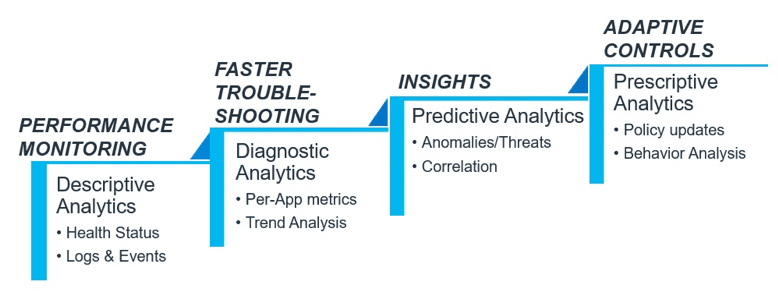
- Performance monitoring: Descriptive analytics to track the health of servers and applications, as well as logs and events.
- Faster troubleshooting: Diagnostic analytics that provide per-application metrics and trend analysis so issues can be resolved as quickly as possible.
- Insights: Predictive analytics to identify anomalies and threats before they start to cause bigger issues.
- Adaptive controls: Prescriptive analytics that use machine learning to recommend policy updates and analyze behavior.
Of course, these three capabilities can’t achieve optimal efficiency without a centralized management system overseeing all of them.
So, an overarching centralized management system is necessary to create a single clear picture and enable universal control across all environments, both now and in the future.
Enterprises must also consider how they can simplify and streamline their microservices and Kubernetes applications. As we discussed above, microservices come with their own set of challenges.
Those challenges can be addressed with solutions that:
- Automatically handle scaling of app services: Solutions should be able to scale app services up and down according to demand.
- Offer operational simplicity with zero touch: Ideal solutions will automatically create new instances when services go down.
- Provide visibility and analytics: Solutions should provide visibility and analytics not just for traffic flowing in and out of apps, but also for traffic flowing between microservices.
Put the pieces together, and you have a comprehensive system that can use management, automation and visibility and control to implement universal policies and configuration across all environments.
Take for example the analytics dashboard of A10 Networks’ Harmony Controller:
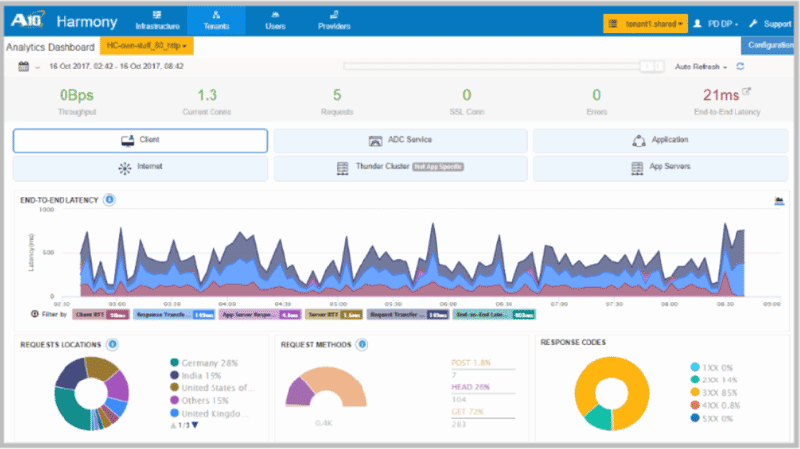
It’s able to:
- Provide comprehensive metrics and logs
- View, monitor and analyze
- Enable efficient troubleshooting
- Generate custom reports
On top of that, it can also:
- Provide per-app visibility into end-to-end latency
- Help troubleshoot response time issues, even on a per-transaction basis
- Identify anomalies and their sources
What Companies Can Do Today
Companies can now implement best practices for application delivery, security and visibility across multiple environments by putting a centralized controller in place.
Let’s compare the simplicity and efficiency of operations without a central controller, versus those with a central controller:
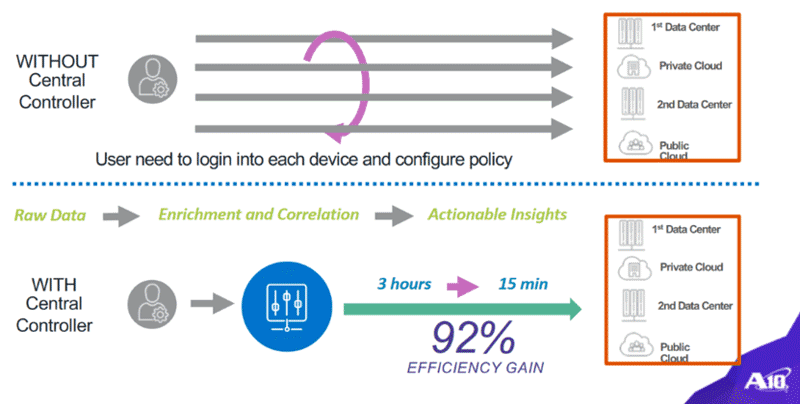
As you can see, a comprehensive central controller converts raw data into actionable insights. This ability can result in a dramatic efficiency gain of 92 percent.
With the right central controller in place, enterprises can:
- Deliver consistent application policy control wherever apps reside, whether they’re on-premises or in the cloud
- Provide integrated security and compliance across multiple environments
- Manage distributed and complex application environments with automation
- Gain visibility and deep insights into application traffic for lightning-fast troubleshooting
This article was based off the topics discussed by A10 Networks’ Almas Raza in our recent webinar, “Best Practices for Application Delivery, Security, & Visibility in the Cloud.”
Additional Resources
- Learn more about A10 Networks’ cloud application security solutions.